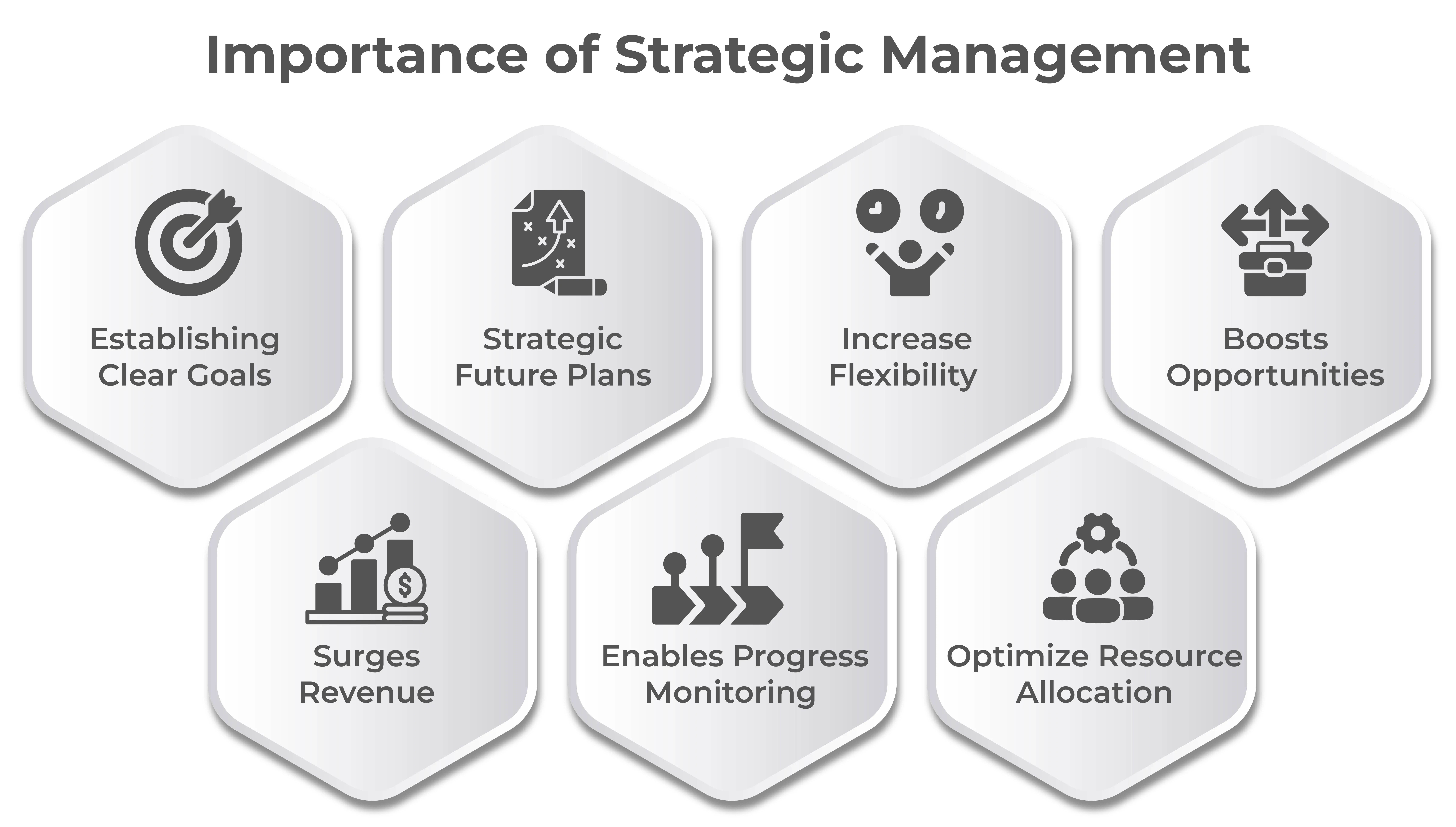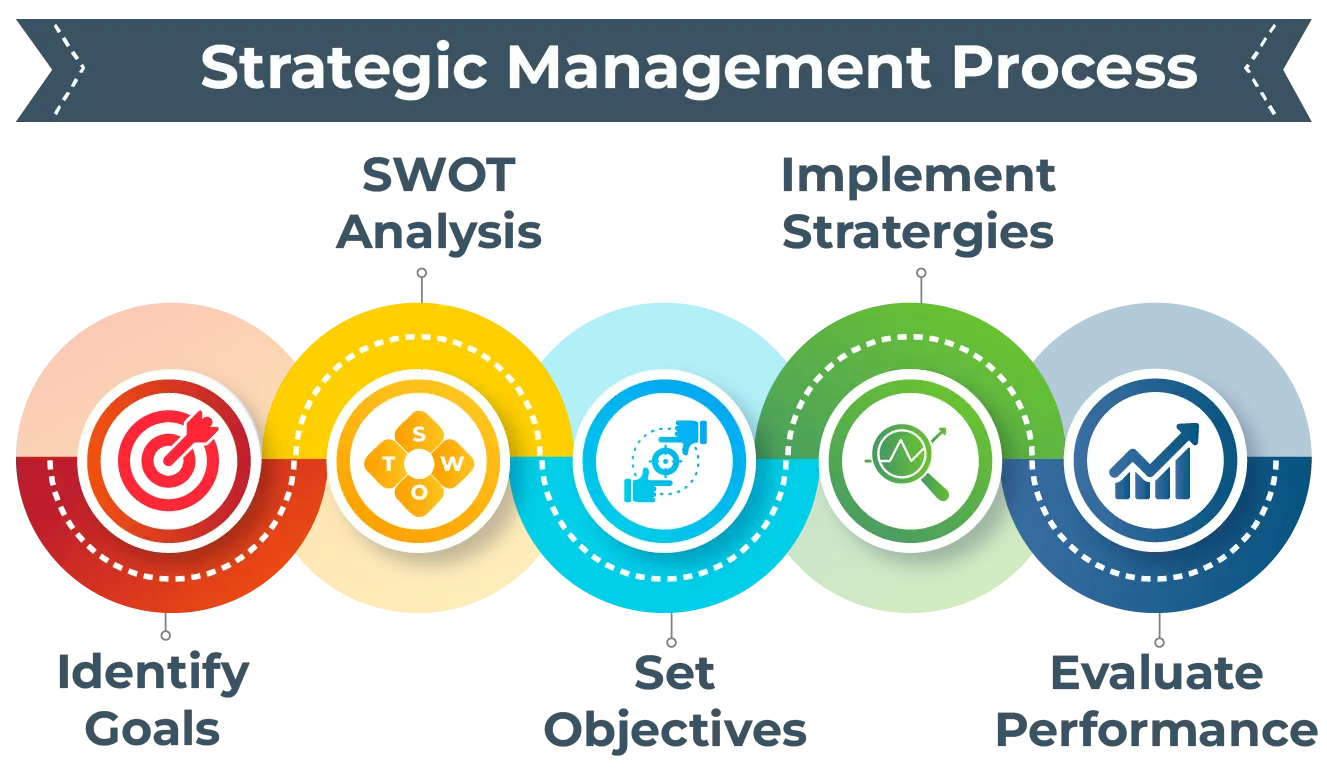Strategic management helps you set up your organization for success. Through effective strategies and robust planning, you can push your company in the right direction to ensure that it achieves its goals. However, since a business is comprised of multiple teams working towards a common goal, it is essential to consider your employees while planning for effective strategic management.
Hence, we will be discussing the various objectives and the importance of strategic management for companies. We will also help you understand the strategic management process through the various steps involved and share examples where it actively helped organizations achieve their long-term goals.
What is Strategic Management?
Strategic Management is the process of planning and applying strategic initiatives for effective utilization of a company’s processes and resources to ensure long-term success. It includes multiple tasks such as planning, monitoring, analysing how resources and being used and finding the most effective means of utilizing them for gaining competitive advantage.
In simple words, strategic management sets a path for the company and its staff to achieve its goals. It continuously plans, tracks, and tests all organizational moves, resulting in better profitability and operational efficiency. Hence, one can say that the importance of strategic management revolves around a company’s clear understanding of its vision and mission.
Importance of Strategic Management
We have already established that strategic management is essential for the long-term success of an organization. Through its numerous objectives, companies can provide their clients and customers with high-quality products and services, while ensuring that its staff remains satisfied and engaged with the company.
Hence, let us check out the relevance of strategic management for organizations, apart from increasing profitability:

1. Establishing Clear Goals
Strategic management helps in establishing transparent goals in an organization. Having clear goals enables everyone in the company to align their efforts towards achieving them. Through the identification of organizational goals, employees can understand why they are being asked to undertake specific tasks, even if they may seem irrelevant within the scope of their work.
2. Strategic Future Plans
Strategic management also helps make future planning easy as its primary function is to strategize plans for improving the organization. When companies have a robust idea of their resources, products, and services, through their strategic management initiatives, they will also be able to make timely decisions based on past patterns. It helps them stay ahead of the competition as it helps them stay prepared for future opportunities.
3. Increase Flexibility
Additionally, it also enables the company to remain flexible since strategic management prepares them for any kind of unforeseen circumstances. As a result, the senior management of the organization would have robust plans in place to adapt to changing markets, evolving technologies, and transforming user perspectives.
4. Boosts Opportunities
Through strategic management, companies can also try out new ideas and concepts, which would be hectic and more time-consuming in the absence of this option. However, strategic management encourages businesses to try out new ideas and implement new concepts. The business would have clear plans in place if the idea or concept failed, letting them take calculated risks, and helping them improve their business.
5. Surges Revenue
Strategic management provides the employees with effective goals to accomplish within the specified period. Along with transparent organizational goals, it enables your staff to improve their performance, which reflects in better quality products and services, translating to increased revenue. Similarly, as the resources are being allocated strategically, companies can also ascertain their competitive position, resulting in more profits.
6. Enables Progress Monitoring
With strategic management, progress becomes measurable as every factor related to company progress would be monitored for making strategic changes. Through continuous monitoring, companies can constantly assess their foothold in the market and make required changes if they observe any negative trends.
7. Optimize Resource Allocation
Strategic management is primarily used for developing strategies for optimized resource allocation. As a result, business costs are reduced while providing the organization with more long-term revenue. Through optimized usage of company resources, organizations can reduce their recurring expenses. This cash flow can be routed to improving employee management initiatives, resulting in increased job satisfaction, engagement, productivity, and retention.
Objectives of Strategic Management
Since strategic management is critical in ensuring organizational success, it needs to be undertaken judiciously. Hence, we should understand the various objectives of strategic management, which helps the HR teams plan how to achieve their objectives.
The need of strategic management can be realized by understanding these objectives:
➔ Ensure Growth
The primary objective of strategic management is to ensure company growth despite the dynamically changing business environment. Hence, these strategies are developed to remain flexible to ensure adaptability with evolving market dynamics and client outlook. To ensure that these initiatives remain relevant, it is also updated frequently to align with the business initiatives.
➔ Mitigate Risks
Similarly, another objective of strategic management is to manage and mitigate the various risks arising from changing factors such as market dynamics, business acumen, buyer perspectives, etc. It helps the organization defend their reputation and performance even during times of turmoil and uncertainty. By mitigating risks, strategic management enables companies to remain adaptable and flexible.
➔ Enhance Efficiency
Strategic management also provides enhanced efficiency through optimized usage of company resources, effective utilization of employee performance, and developing a culture of increased efficiency. Additionally, it also ensures that the employees are provided adequate training through training management system to ensure excellent performance, leading to increased productivity and efficiency.
➔ Align Efforts
It also ensures that all strategies and efforts undertaken at the organizational level are aligned to ensure success. Hence, strategic management aligns the various strategic objectives with work being undertaken, while ensuring collaboration and transparent communication. It also provides avenues for employee growth and engagement to ensure better productivity for ensuring long-term success.
➔ Optimize Resources
Another major objective for strategic management is to optimize the utilization of every available resource to ensure its maximum utilization. While it is easier to allocate adequate tangible resources such as money, time, etc. for achieving specific goals, non-tangible resources such as human effort, performance, and skills remain hard to measure. However, through strategic management, you can ensure that these non-tangible resources are also being utilized according to organizational requirements.
➔ Ensure Flexibility
Strategic management also ensures complete flexibility for the organization by including contingency plans as well as providing various options to achieve organizational objectives. It enables the organization to respond to market changes and technological shifts, enabling it to have a competitive advantage even during harsh market conditions.
Developing a Strategic Management Process
Since strategic management is critical for the success of an organization, it should be developed with accurate planning and more precise implementation. Since each company is unique, developing a custom strategic management process for your organization requires in-depth planning; and a one-size-fits-all solution will not help.
However, you can start with the steps provided below:

1. Identify Goals
All business processes are aimed at fulfilling specific goals, and the same applies to strategic management. Hence, you should have a clear view of the end goal before setting up a strategic management process. To fulfil this requirement, it is essential to have a well-defined organizational vision and mission statement and establish what you wish to achieve through the strategic management process.
Additionally, you should also check out the current strategies in place. For example, the senior management may be concentrating on expanding your business to new markets or getting more profits from existing business. Once you decide on the new goals, you can either merge the existing strategies to create a new one for the new goal, or scrap the existing one and create a new strategy to ensure the success of the strategic management process.
2. Undertake SWOT Analysis
Once you have decided on the goals, the next step is to analyse your company thoroughly for all metrics that can be measured. Organizations generally use the SWOT or Strengths, Weaknesses, Opportunities, and Threats technique to analyse their business. It helps understand the inherent strengths and weaknesses within the organization, as well as comprehend the opportunities for growth as well as the threats standing in the way.
Once the factors are identified, you can start working on them to ensure that the business remains prosperous, while having healthy competition. Similarly, you can also analyse other external factors that work for the success of the organization such as the market trends and the technological advancements in the market to understand the changes required for the fulfilment of the long-term growth strategies.
3. Set Objectives
Once your metrics are analysed, you can set the objectives for strategic management to accomplish. The objectives must follow the SMART approach, which ensures that they are Specific, Measurable, Achievable, Relevant, and Time-bound. By setting the objectives, you can create a robust strategy to achieve them.
By identifying the objectives for strategic management, you can develop strategic plans that ensure the success of the organization. Hence, the objectives should be precise and any documentation related to it should be undertaken accurately to avoid any misunderstandings. Additionally, one must align the company objectives and vision so that the organization can move in a profitable direction.
4. Implement Stratergies
Once you finalize these goals for various departments in the organization such as finance or marketing, the next step in strategic management is to allocate resources for achieving them. You need to ensure that every individual and department in the organization has the necessary resources they need for the successful implementation of the organizational strategy.
Providing the new and well as existing employees with all the resources and training they need to achieve their targets is also a component in the implementation of strategic management. Additionally, you should also have the right systems in place to ensure that everyone can undertake their tasks efficiently.
5. Evaluate Performance
Once the strategies are in place, you need to start monitoring their performance through a performance management system, to ensure the achievement of organizational goals. By evaluating the performance of the strategies, you will be able to take corrective measures if any factor is not going according to plan.
Since strategic management considers the different factors that are out of our control, it is essential to monitor the performance of the strategies. Based on employees’ performance and their response to the organizational strategy, it is best to adapt to the situation and modify existing strategies or draft new ones, whenever the current one is not working.
Examples of Effective Strategic Management
Here are a few examples where strategic management enhanced the profitability of an organization:
- Apple: Apple has created a strong brand value through strategic product diversification, ecosystem integration, retail experience, and resonating ads. All these factors have contributed to making them a premium brand.
- Netflix: Netflix has strategically transformed from a content distributor to a content creator to ensure steady income via its subscription model of pricing. To ensure a competitive advantage, they share data-driven personalized experiences with each user along with heavy investment in streaming technology.
- Tesla: Tesla established ‘gigafactories’ for hyper-efficient scaling of their innovative Electric Vehicle (EV) development platforms. Their innovations in battery technologies and autonomous driving resulted in renewed interest in EVs, while their direct-to-consumer approach enabled them to gain a strong foothold in the market.
- Airbnb: While Airbnb started as a marketplace for hosts and guests, it has evolved into a community-driven experience and adventure provider. Their user-centric ideologies have enabled them to grow globally, helping them forge strategic partnerships locally for a competitive advantage.
- Amazon: Amazon is a highly user-centric brand, which has enabled it to dominate the e-commerce sector for a long time. They have also diversified their products while also introducing Amazon Prime, enabling user retention. Additionally, their investment in robotics also proved fruitful in optimizing their supply chain management.
Conclusion
As companies grow, strategic management remains an integral part of it. Through strategic management, organizations can understand their strengths and weaknesses and make the necessary changes to take on their competition. As a result, strategic management ensures long-term success for any business.
FAQs on Importance of Strategic Management
1. Why is Strategic Management Important for businesses?
The importance of strategic management for businesses cannot be overstated as it enables them to understand where they stand in the market. It also helps them understand their advantages and disadvantages, enabling them to strategize tailored programs to improve their business and gain long-term success.
2. What are the primary benefits of Strategic Management?
The importance of strategic management can be understood by the numerous benefits it provides to organizations, such as:
- Easy planning
- Optimal resource usage
- Improved flexibility
- Increased revenue
- Enhanced innovation
- Better decision-making
- Competitive advantage
- Increased stability.
3. Why is Strategic Management Important for long-term planning?
The significance of strategic management for long-term planning is high as it provides a structured approach to setting organizational goals, allocating the required resources, and adapting to any changes. It leads to sustained success and long-term growth.
4. How does Strategic Management contribute to organizational growth?
Strategic management contributes to organizational growth by enabling the development of a roadmap for the company’s future. It enables better decision-making and resource allocation, resulting in enhanced efficiency. As a result, strategic management results in increased profitability and a stronger competitive position in the market.
5. Why is Strategic Management Important for workforce planning?
The significance of strategic management for workforce planning is huge as it ensures that an organization’s human resources are aligned with its long-term goals. It enables them to effectively support the business to fulfil its organizational objectives. As a result, strategic management enables companies to identify skills gaps, predict future talent requirements, and develop strategies to hire and retain the right people.









